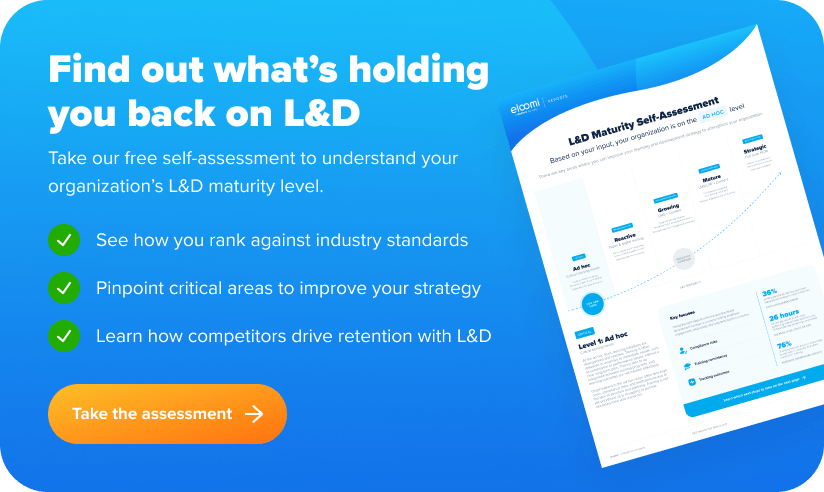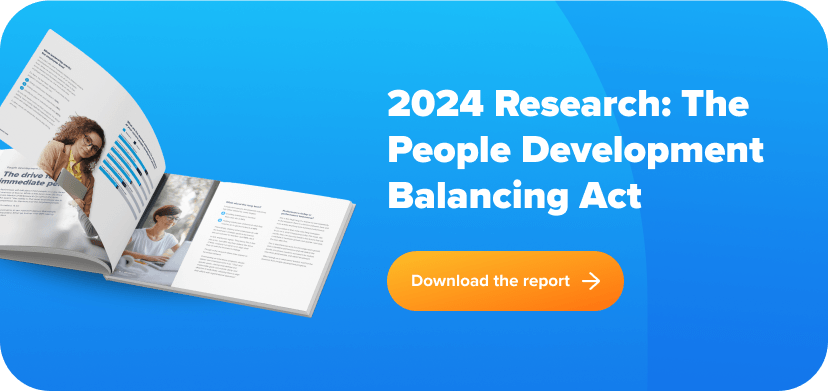Did you know that as reported by The Balance Careers, “only 49 percent of employees find that reviews are accurate, while 90 percent of HR heads believe annual reviews do not yield accurate information”? This could be why companies are starting to get rid of the outdated idea of an annual employee review and are replacing it with quarterly or even more frequent performance feedback sessions.
Let’s look at some interesting stats from the eloomi 2024 People Development Report
-32% of leaders believe individual performance is discussed weekly, yet just 26% of employees report this happening;
-26% of leaders believe employees are given weekly opportunities to deliver feedback about their managers, yet just 19% of employees say this is accurate;
– 25% of leaders think that managers check in with employees about their well-being on a daily basis, only 15% of employees say this happens.
By taking away the dark cloud of the “annual review” and providing more frequent opportunities, managers have a chance to give current feedback which provides valuable insights.

What is an employee performance review?
Before understanding the best ways to conduct an employee performance review, it is essential to have a complete understanding of what this process involves and why its success is so important for the future of your employees and your company.
An employee performance review is a structured process where a line manager or an HR manager evaluates an employee’s job performance over a specific period. This evaluation includes assessing the employee’s achievements, strengths, areas for improvement and overall contribution to the team and company. During the review, the manager provides constructive feedback, recognizes accomplishments, and addresses any performance issues.
The review also involves setting future performance goals and discussing career development opportunities to support the employee’s growth and advancement within the organization.
Why is this process so important?
Performance reviews aim to enhance employee engagement, align individual and company goals, strengthen communication and encourage a culture of continuous improvement.
This process will set your employees for success, making them accountable for their work and performance, encouraging them to take ownership of their tasks and responsibilities. But, it also helps employees prioritize tasks that directly contribute to the company’s goals, improving overall productivity and making them feel they are actively contributing to your whole company’s success.
Tips on how to conduct a successful employee performance review
The conversations on goals and objectives are all about creating more impactful (and practical) takeaways from each manager-employee check-in. These discussions should aim to create impactful and practical takeaways that drive both individual and organizational success.
By focusing on clear, actionable feedback and setting well-defined goals, managers can ensure that each check-in not only addresses current performance but also fosters growth and development. In this way, performance reviews can become a powerful tool for enhancing productivity and advancing careers. Here we have gathered a few tips on conducting an effective performance review:
1. Be clear in predetermined goals and expectations
A clear definition of goals and expectations is the perfect foundation for an effective performance review. The goals and expectations should be established at the beginning of the employment and should be reviewed regularly, making sure they match the development of the employee in your company and organizational objectives.
This clarity helps employees focus their efforts and provides a benchmark against which their performance can be measured (KPI). Communicate these goals in detail and you will see how this approach minimizes ambiguity and ensures that both managers and employees have a shared understanding of success criteria.
2. Keep regular records of employee performance
Keeping regular notes of employee performance is essential for an accurate and comprehensive performance review. Documenting observations, achievements, challenges and progress throughout the review period will make writing your review easier and based on a factual feedback basis for evaluation.
We would recommend using a consistent format for these records to track performance trends.
3. Gather other feedback and write your review
A useful practice is to incorporate feedback from various sources to yours in order to create a well-rounded performance review. This multi-source feedback, often known as 360-degree feedback, provides different perspectives on the employee’s performance and behavior.
Combine this input with your own observations to draft a balanced review that reflects the employee’s strengths, areas for improvement, and overall contribution.

4. Prepare for the meeting
Preparation is key to the success of the performance review meeting. Review the employee’s performance records, feedback from others, and any relevant documentation before the meeting. We also recommend planning the structure of the discussion when possible, including the main points you wish to address, and anticipate potential questions or concerns the employee may raise.
The review should start with the review of the pre-established goals, focusing with positivity and motivation on the progress made and sharing any constructive feedback you have prepared. Prepare not only todiscuss actionable goals but also development opportunities, ensuring the meeting is constructive and forward-looking. Make sure to keep notes on what is discussed to be able to provide the employee with a follow-up plan.
5. Follow-up tips
After the performance review meeting, follow up to ensure that agreed-upon actions and development plans are being implemented.
It is recommended to schedule regular check-ins to monitor progress, provide additional support and address any new issues that may arise. Effective follow-up reinforces the commitments made during the review, and demonstrates ongoing support for the employee’s growth and success.
Deliver performance reviews in just a few clicks with eloomi
With performance review processes, 1-1 conversations, and goals and objectives ready to go, it’s simple to deliver reports and check in on progress in the manager dashboard with eloomi. This view allows managers and HR to easily share outcomes from people development initiatives, narrow-in on individual performance, or see department-wide results in just a few clicks, for example:
-Managers will always be able to see the progress and completion of an appraisal
-Employees are notified, by reminders, during the appraisal process and have access to their appraisal on their page
-Goals and objectives connects to the employee profile, where feedback and 1-1 check-ins can begin
-HR can quickly begin to review any plans and support where necessary. They also will have access to any data needed via eloomi’s Insights reporting.
How to give feedback in a performance review?
The task of employee feedback during a performance review is a crucial step for the success of individual development, team cohesion, and overall organizational growth.
However, for managers and HR individuals it is always considered as daunting due to the challenges of balancing constructive criticism with encouragement and addressing sensitive issues at the same time.
We gathered four of the best ways to give employee feedback so that you can make the process a little less painful for both employees and managers.
1. Always be specific
Employee feedback should be specific. A general comment like, “I think you could be doing better” will not resolve the concern. The more detailed specifics you give, the more likely you will get the results you are looking for. The same goes for positive comments. By saying, “you are doing a good job”, your employee will not know which positive things they are doing that you would like to see more of. Although positive general feedback leaves them walking away feeling like a star student, it does not give them the opportunity to continue to perform to their best.
2. Try the 3×3 employee feedback method
Originally proposed by Bert Decker in his book, “You’ve Got To Be Believed To Be Heard”, the 3×3 method is a way to effectively give feedback. By providing an employee with three strengths & three areas of potential development, they will see the changes as a challenge instead of a criticism. Decker, the man behind the method says, “Receiving three bits of feedback at a time allows people to make course corrections, like a guided missile, as they keep moving onward and upward.”
3. Provide employees with the tools to succeed
Feedback means nothing if there is no way for an employee to make the corrections. Provide your team with the tools to effectively make the changes you feel are needed. Implementing tools like more support or additional training may take time at first but it will allow your employee to be more successful in the long run.
4. End employee feedback on a positive note
Many employees walk away from a feedback meeting feeling defeated. This is because often the positive things are said in the beginning to calm nerves but that means the constructive criticism comes at the end. By letting an employee walk away on the negative, they will forget all the positives they were once given. Try presenting the issues you feel need to be fixed at the start of your conversation and end it with all the things they do that you appreciate. You might be surprised how much they respond to it and how fast the results of your feedback is seen.
Build better performance reviews with eloomi
Breathing new life into your performance reviews to drive culture and values has never been more crucial. Modern performance review processes need to keep pace with a changing culture of the workplace and new employee expectations. So why not explore a modern solution?
With eloomi Journeys, HR can set up workflows for employee performance reviews and automate processes across the organization, or even tailor workflows for departments, teams, or even groups of employees. Perhaps you’d like a unique performance review path for employees on leadership and management development tracks? With eloomi, that’s no problem.
At eloomi, we are passionate about this topic and have real, hands-on experiences to share with you. Our goal is to be helpful to you as you explore the best ways and options to succeed. Begin a conversation with us to learn how eloomi can help you create your ideal performance reviews.








